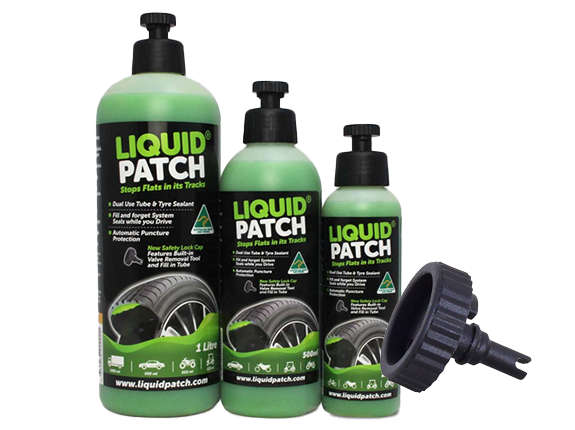Installation

The pump delivers approximately 250ml LIQUID PATCH per downstroke. Prior to commencing installation, check the volume of delivery with a measuring cup.
- Mix LIQUID PATCH well before installation. It is important to ensure proper mixing to obtain the best results. Failure to mix thoroughly may impair the sealing and balancing qualities.
- Remove the valve core and connect the quick attach coupler on the pump hose to the valve stem SECURELY. It is not necessary to completely deflate the tyre. However, reducing the air pressure will make pumping easier.
- Open the shut off valve on the hose at the pump handle,
- Apply the recommended quantity of LIQUID PATCH into the tyre by lifting the pump
handle completely to the top and then depressing it to the bottom. Each downstroke
should dispense approximately 250ml. Please note PUMP CALIBRATION section - Shut off the valve at the pump handle before disconnecting from the valve stem. This prevents the LIQUID PATCH from flowing out of the hose into the outrushing airstream at the valve stem. Place rag over the coupling valve stem and disconnect. This prevents any LIQUID PATCH in the valve stem from spraying you.
- Install the valve core and inflate the tyre to the recommended pressure.
- For proper distribution of LIQUID PATCH within the tyre, the vehicle should be driven for several kilometres.
- Always identify the tyres containing LIQUID PATCH to prevent doubt treatment. This can be done with a spot of yellow paint on the valve stem.
- Wash off the pump hose coupling. Wash out the entire pump twice per month to prevent fibre build up at the ball foot valve inside.
- If the ball foot valve at the base of the pump should become clogged with fibres, some, or all of the LIQUID PATCH will not be injected into the tyre.
- Proper attention to these instructions will greatly assist in achieving maximum performance from LIQUID PATCH
NOTE: DO NOT DILUTE LIQUID PATCH BEFORE INSTALLATION
LIQUID PATCH must be used at full strength. Dilution will affect the anti-freeze capabilities, corrosion inhibitor strength and will impair balancing and sealing capabilities.

How LIQUID PATCH Works
Install LIQUID PATCH into your tyre, see the instruction for the specified amount. As the wheel rotates LIQUID PATCH distributes itself evenly in the tread area. When a puncture occurs, pressure of the escaping air forces LIQUID PATCH into the punctured area. LIQUID PATCHS technology will then form a long lasting Flexible plug in the punctured area. Air loss is then blocked quickly and a flat tyre is Prevented.
Note:
- Never to be diluted. Cannot be used with any other sealant.
- Rotate tyre so valve stem is at either 4 or 8 o’clock.
- Shake bottle well before use.
- Pull cap up to expose filling tube, remove cap using built-in valve core remove tool
- Insert cap/valve tool into valve and turn anti-clockwise to remove valve core and fully deflate tyre.
- Sliding filling tube over valve stem and slowly squeeze your required amount of sealant into the tyre, as per the above method.
(W x H x .5 = required mls) - Re-install the valve core using the cap tool, turning clockwise. Do not over tighten.
- Inflate tyre to the manufacturer’s recommended pressure.
- For optimum results, rotate the wheel multiple times to coat the tyre and activate seal.
- Rinse bottle and dispose into a recycling bin.
IMPORTANT: If using for “on-road” vehicles, check tyre for cuts or other damage. If note, use liquid patch as a temporary repair, reduce driving speed < 8o km/h, and have your tyre inspected as soon as possible by a tyre service professional. Tyre sealants are not designed to repair damage to tyre shoulder and side wall, you
should seek advice from a tyre service professional.
CONDITION OF SEAL: Only to be used in strict accordance with the manufacturer’s instructions. The supplier/manufacturer takes no responsibility for any damage, injury, or loss directly or indirectly as a result of the use of this product.
NOTE : LIQUID PATCH should be used at full strength never dilute with water.
| Average amount of LIQUID PATCH required per tyre | |
|---|---|
| Bicycles, Golf carts, Wheelchairs | 125 ml |
| Farm trailers, Ride on mowers | 250 ml |
| Cars, Caravans, Car trailers | 500 ml |
| 4WDs, Off-road Recreational Vehicles | 750 ml |
| Trucks and vans | 1000 ml |